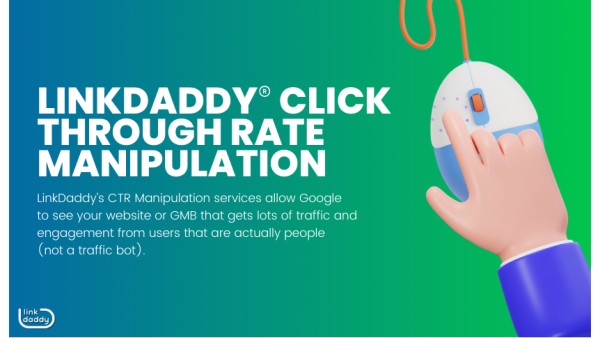Optimize Your Google My Business Listing with GMB CTR Manipulation
Optimize Your Google My Business Listing with GMB CTR Manipulation
Blog Article
Maximizing Organic Click-Through Fees With CTR Manipulation
The optimization of organic click-through rates (CTR) is a nuanced endeavor that pivots on recognizing both customer psychology and reliable material presentation. The landscape is swarming with misunderstandings and oversimplifications regarding what really drives CTR.
Understanding Click-Through Fees
Recognizing click-through prices (CTR) is important for assessing the effectiveness of online advertising and marketing approaches. CTR determines the portion of users who click a particular web link or promotion contrasted to the overall number of users that see it. A higher CTR shows that the web content is engaging and pertinent to the target audience, while a lower CTR might indicate a need for optimization.
To compute CTR, split the number of clicks by the variety of impacts and increase by 100. As an example, if an advertisement gets 300 clicks out of 10,000 impressions, the CTR would certainly be 3%. This metric is crucial for assessing different elements of electronic advertising, consisting of search engine optimization (SEO), email campaigns, and social media sites marketing.
Moreover, evaluating CTR aids marketers recognize which strategies generate the best outcomes and which require improvement. By concentrating on enhancing CTR, organizations can enhance their material's presence and efficiency, bring about raised website traffic and potential conversions. Comprehending the subtleties of CTR is fundamental for any type of marketing professional intending to optimize their on the internet visibility and optimize roi (ROI)

The Psychology of Individual Behavior
User behavior is significantly affected by emotional variables that determine how people engage with on the internet material. Understanding these elements is necessary for enhancing click-through rates (CTR) in organic search results page. Cognitive prejudices, such as the anchoring result, play a vital function fit customers' understandings. When individuals encounter info, their initial impressions can greatly influence their subsequent judgments concerning significance and reliability.
Emotional actions also substantially influence user habits. Content that resonates psychologically can set off a feeling of necessity or curiosity, triggering customers to click. Additionally, social proof-- such as individual testimonials or ratings-- can improve trust fund and encourage interaction, as people often want to the actions of others to educate their own decisions.
Additionally, the concept of deficiency can drive clicks - CTR Manipulation Press Release. Limited-time deals or exclusive material develop a concern of losing out (FOMO), compelling individuals to act promptly. Understanding these psychological vehicle drivers makes it possible for marketing professionals to develop even more engaging web content that reverberates with their target audience
Effective CTR Adjustment Techniques
Leveraging mental insights can significantly enhance click-through rates (CTR) via targeted manipulation techniques. Among one of the most reliable methods is making use of engaging headlines that evoke inquisitiveness or necessity. Wording titles as questions or integrating numbers can draw in more attention, prompting customers to click.
One more technique entails optimizing meta summaries to develop a feeling of significance and immediacy. By clearly outlining the options or benefits offered in the content, you can involve prospective readers and persuade them to click. In addition, using power words-- such as "exclusive," "proven," or "cost-free"-- can boost the charm of your content.
Visual elements additionally play a crucial duty. Integrating attractive photos or thumbnails can draw users in other and boost CTR. A/B testing different visuals can assist identify which photos resonate ideal with your audience.
Finally, guaranteeing that your content guarantees deliverable value causes higher CTR. When customers perceive that clicking will certainly offer them with purposeful understandings or options, they are a lot more most likely to involve. By utilizing these techniques thoughtfully, online marketers can properly manipulate CTR to their benefit while keeping ethical requirements.
Usual Myths Regarding CTR
A number of misunderstandings surround click-through prices (CTR) that can lead marketing experts to make illinformed decisions. While a high CTR suggests that even more individuals are clicking, it does not assure sales or conversions.
One more typical belief is that CTR is an isolated metric. In truth, CTR should be evaluated together with various other efficiency signs, such as bounce rate and conversion rate, to obtain an alternative view of project success.
Additionally, some marketers think that optimizing for CTR alone is adequate. Focusing solely on CTR can lead to clickbait strategies that may bring in clicks however fail to involve users meaningfully. CTR Manipulation. This method can harm brand name track record and cause reduced retention rates
Last but not least, there is a concept that CTR strategies are widely effective. The reality is that optimal CTR techniques can vary dramatically across sectors and target audiences, demanding tailored approaches for different market sectors. Understanding these myths is important for click reference establishing effective CTR techniques that align with overarching advertising and marketing goals.
Determining CTR Success
Although high click-through rates (CTR) can suggest effective involvement with material, gauging their true success needs a thorough analysis of a number of variables. It is necessary to understand the context in which the CTR is accomplished. For example, a high CTR on a deceptive title may not translate to significant interaction or conversions, inevitably reflecting badly on the brand name's credibility.
2nd, evaluating the source of traffic is important. Organic web traffic from online search engine can indicate a durable web content strategy, while clicks from irrelevant sources may indicate a lack of targeting. Additionally, determining the succeeding individual habits is crucial; examining metrics such as bounce price, time invested on web page, and conversion rates can offer deeper insights into the quality of the engagement initiated by the CTR.

Conclusion

The optimization of organic click-through rates (CTR) is a nuanced undertaking that hinges on recognizing both individual psychology and effective material discussion. CTR determines the percent of individuals that click on a certain web link or ad contrasted to the total number of customers who see it. A greater CTR suggests that the web content is engaging and appropriate to the target audience, while a reduced CTR may indicate a need for optimization.
Focusing specifically on CTR can lead to clickbait strategies that might attract clicks however fall short to engage individuals meaningfully. Furthermore, gauging the subsequent individual actions is vital; examining metrics such as bounce price, time invested on page, and conversion rates this page can give much deeper understandings into the quality of the involvement initiated by the CTR.
Report this page